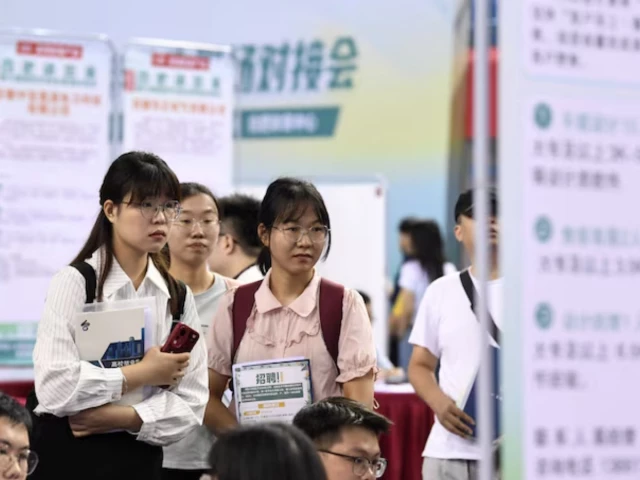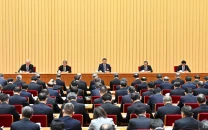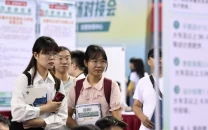China's planned emancipation of 'half the sky'
The century-long revolution that made Chinese women engines of modernisation

When Mao Zedong declared that “women hold up half the sky,” he was not reciting poetry. He was issuing a revolutionary programme, marking a civilisational break: from centuries of feudal subjugation to a project of socialist reconstruction that placed gender equality at its core.
Seventy-five years later, the evidence of that revolution is everywhere. Chinese women, once excluded from literacy, property and politics, are now among the most educated, employed and empowered citizens on earth
The results of these policies are visible in statistics and in lives changed. Women now account for about 43% of China’s total employed population, up from roughly 20% in the early communist era, which is higher than the global average and on par with many developed countries.
In fact, Chinese women today are a formidable presence in fields like science and technology, comprising 45.8% of the country’s researchers and innovators, contributing to cutting-edge industries and scientific breakthroughs. By comparison, women make up only about 28% of scientific researchers in the United States.
China’s first Nobel Prize in science was awarded to a woman, pharmacologist Tu Youyou, for discovering a malaria treatment – a feat emblematic of Chinese women “scaling new heights at the forefront of innovation”.
In the business realm, Chinese women have also made waves. According to the Hurun Report, two-thirds of the world’s self-made female billionaires are Chinese. These include entrepreneurs like Zhou Qunfei, a factory girl-turned-tech CEO, and countless lesser-known women who founded successful companies.
What sets China’s model apart is that women’s liberation was never an appendage to modernisation, it was its condition. From the Marriage Law of 1950 to decades of rural education and industrial inclusion, equality was encoded in the foundations of socialist development.
The long march of women comrades
China has essentially closed the gender gap in schooling: girls’ primary enrolment has long hovered above 99.9%, secondary completion approaches universality, and women now constitute 50.76% of undergraduates and about half of graduate students – roughly 50% in 2024 – up from about 36% in 1995.
The country’s adult and vocational systems mirror this rise, with women accounting for nearly 54% of adult learners. By 2024, 2.85 million women were working in R&D – an increase of 1.69 million since 2012 – feeding a scientific ecosystem in which female researchers make up 45.8% nationwide.
Work followed education. During the Mao era, women’s labour-force participation surpassed 90% -- the highest in the world at the time – as the “Iron Girls” ethic prised open heavy industry, agriculture and professional work.
Market reforms dented those heights but did not undo the transformation: women remain a formidable share of the workforce, often cited at about 70%, and they hold 42.6% of jobs across government agencies, public institutions and state-owned enterprises.
Professional ladders have shortened: women now occupy 50.6% of associate senior professional posts (and 44% at senior level) in education, health and research.
Material emancipation shows up most clearly in poverty and health. By 2020, China had eradicated extreme rural poverty, lifting around 850 million people – about 76% of global poverty reduction over four decades – with women constituting roughly half of the beneficiaries.
The state’s gender-responsive programmes mattered: more than ¥450 billion RMB (about US$63 billion) in microloans empowered 8.7 million formerly impoverished women; between 2015 and 2020, the All-China Women’s Federation helped over five million rural women exit poverty through cooperatives, handicrafts, and digital commerce.
Health gains track the same arc. Female life expectancy has doubled since the early 1950s to 80.9 years (2020). Maternal mortality collapsed from an estimated 1,500 per 100,000 live births in 1949 to 17.8 per 100,000 in 2019—an 80-fold decline—underpinned by hospital delivery rates above 99% since 2012 and basic medical insurance that now covers some 651 million women.
These are not abstract entitlements as they translate into longer lives, safer births and real bodily autonomy.
Law supplied the scaffolding. The 1950 Marriage Law, often called China’s first feminist statute, abolished arranged and child marriages, banned polygamy and concubinage, set minimum marriage ages – 18 for women, 20 for men – and made divorce a right, not a privilege.
Thousands of women exercised that right in the 1950s, upending a patriarchal family order. Constitutional guarantees in 1954 and 1982 entrenched equality across political, economic, cultural, social, and family life.
The 1992 Law on the Protection of Women’s Rights and Interests consolidated property, educational, occupational and personal rights. Amendments in 2005, 2018, and a sweeping 2022 revision broadened protections against discrimination and sexual harassment, mandated gender-impact assessments for new laws, and expanded legal aid and public-interest litigation.
The 2015 Anti-Domestic Violence Law introduced restraining orders, a nationwide hotline, and clear enforcement mechanisms. Sustained campaigns since 2013 have reduced bride trafficking and the abduction of women by 95%. The result is a rule-of-law architecture that makes equality actionable.
Education deserves a closer look because it was the keystone. In 1949, the old adage that “ignorance is a woman’s virtue” still carried force as schools were closed to most girls, especially in the countryside.
The new state inverted that logic: literacy drives in the 1950s, nine-year compulsory education since 1986, aggressive rural school expansion, free textbooks, and the recruitment of female teachers normalised girls’ schooling.
Families responded, investing in daughters as well as sons. Targeted incentives and STEM pipelines nudged women toward fields once coded male. The effect compound: as daughters entered high school and university in greater numbers – now slightly over half in regular high schools and 50.76% at the undergraduate level – biases eroded and an educated female cohort reshaped the labour market.
While Western feminists fought for decades for legal abortion or maternity leave, the socialist state in China relatively quickly instituted accessible abortion and generous maternity leave as part of labour law, because these were seen as benefiting societal welfare.
China’s global feminist leadership
Meanwhile, China has emerged as a major force in global gender equality, particularly across the developing world.
Once peripheral to international women’s rights discourse, it now helps shape it. The turning point came in 1995 when Beijing hosted the UN Fourth World Conference on Women, where Hillary Clinton declared “women’s rights are human rights”.
Thirty years later, China marked the anniversary with the 2025 Global Women’s Summit in Beijing, where President Xi Jinping called for a world in which women “share in the benefits” of development, linking gender equality to peace, stability and economic growth.
He urged support for women’s roles in peacebuilding and highlighted technology and green industries as new avenues for empowerment.
The advocacy rests on extensive initiatives. Since 2012, China has convened nearly 30 international conferences for women leaders under APEC, the G20, the Belt and Road Initiative (BRI), and other platforms, promoting what is often called the “Chinese approach”: equality through development.
Under the BRI, programmes such as the Silk Road Women’s Initiative and e-commerce training for women in partner states have expanded job opportunities in construction, renewable energy, and logistics.
For a decade, China has hosted events themed “Pooling Women’s Strength for Belt and Road Cooperation,” encouraging women to become “supporters, participants, and beneficiaries” of global infrastructure projects.
Through the South–South Cooperation Assistance Fund, China has implemented 100 maternal-child health and 100 school projects, investing about $40 million in more than 20 countries. One celebrated example is Juncao technology, a method of cultivating mushrooms from wild grasses.
Women in 106 countries have learned this low-cost innovation, creating micro-businesses that improve food security and household income. In Fiji and Lesotho, Juncao training has elevated women to community leadership, earning the crop the nickname “grass of happiness”.
China has also made education and leadership training central to its gender diplomacy. Since 2018, it has organised more than 100 programmes for women officials from Asia, Africa and Latin America, and established a Global Women’s Development and Training Base in Beijing.
China’s commitment extends into peace and security. It supports the UN Women, Peace and Security agenda and has deployed over 1,200 female peacekeepers and 100 female police officers to missions in South Sudan, Lebanon, and elsewhere.
In 2020, Major Xin Yuan received the UN Military Gender Advocate Award for her work in a peacekeeping mission. China has since co-launched UN training for senior female peacekeeping leaders, furthering Xi’s call for a “shared global duty” in women’s advancement.
Today, China is the second-largest donor to UN Women’s core budget, and its stewardship of the Beijing Declaration and Platform for Action keeps international attention fixed on education, health and poverty reduction – areas of its proven strength.
Chinese approach to women’s emancipation
The foundation of China’s gender revolution lies in Marxist and socialist feminism adapted to Chinese realities. Unlike liberal feminism in the West, which arose against state power, China’s was state-led: women’s emancipation was part of a broader socialist transformation.
The Communist Party of China (CPC) viewed women’s liberation as inseparable from class struggle and national rejuvenation. It held that women’s oppression emerged with private property and could only be abolished through social revolution.
Early thinkers such as He-Yin Zhen, Zhou Enlai, and Xiang Jingyu linked patriarchy to feudal and capitalist exploitation, concluding that socialism alone could ensure true equality.
After 1949, Mao Zedong and his comrades translated these ideas into policy, mobilising women as a productive force for development and justice.
The All-China Women’s Federation, founded before the PRC’s birth, organised women nationwide under Party leadership, making gender equality a core policy rather than a peripheral cause.
The Mao era introduced cafeterias, nurseries and “houses of happiness” for the elderly, easing the domestic burden on women. In Xi Jinping’s “New Era”, women remain both beneficiaries and architects of modernisation.
The writer is an independent journalist.




















COMMENTS
Comments are moderated and generally will be posted if they are on-topic and not abusive.
For more information, please see our Comments FAQ